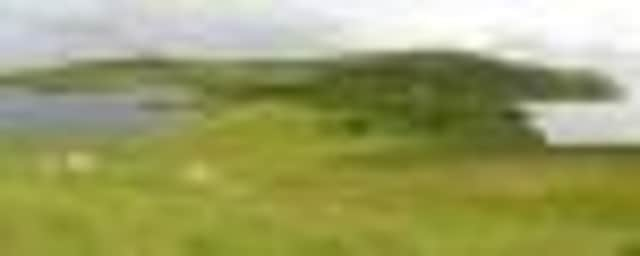Norse power


It’s 10pm in the lounge of a B&B on the lonely Shetland island of Unst and the proprietor has asked if I’d like to see his giant axe. Normally, as an innocent touring cyclist I might be wary of such invitations but not here. For one thing at this latitude it’s still broad daylight; for another the chap concerned is the amicable Gerry Firmin. He relocated from Essex to Unst in the 1970s to serve at the island’s former RAF base and crowned his acceptance into the community in 1991 by becoming guizer jarl for the Up Helly Aa at Uyeasound where he lives.
Some explanation is needed. Up Helly Aa is a descendant of the ancient feast of Yule held by Norsemen to celebrate the rebirth of the sun in late January. Dressed as Vikings, men and women (called guizers) form themselves into squads under the leadership of the guizer jarl (translated as “earl”). They march through the their town or village bearing torches and pulling a boat – a longship in the case of the major Lerwick festival – into which they cast their torches to create a bonfire.
Advertisement
Hide AdAdvertisement
Hide AdThe Viking influence pervades Shetland. These islands – much closer to Bergen than Edinburgh – were governed from Norway up to 1469. My favourite place name is Muckle Flugga which translates as “large, steep-sided island”. Topped by a lighthouse, the island – which I’d viewed from the Hermaness nature reserve – is the northernmost point of the British Isles. A few miles south I came across a replica of a Viking longboat undergoing reconstruction. Named Skidbladner, the vessel came to Unst in 2000 during a voyage from Sweden. The aim of the sailors had been to recreate a north Atlantic crossing made by Norwegian explorer Leif Ericson in the ninth-century. They failed – but couldn’t have chosen a more fitting spot to come ashore.
I didn’t realise there was a Shetland dialect before my visit. I loved the Keep Shetland Tidy slogan: “Dunna Chuck Bruck”. Nothing lost in translation there. The local accent is a weird blend of Scots and Norwegian and also takes sounds from Denmark and Germany, former trading partners. I found out more about the language – derived from the Old Norse – at the excellent Shetland Museum in Lerwick, the islands’ only town and capital.
Outside the museum on decking over Hays Dock is an art installation entitled Shetland Receivers. It consists of six funnels emitting recordings of life on Shetland which, linked to an anemometer, change with the wind speed and direction. The creative side of the islands is being fostered next door in the purpose-built Mareel music, cinema and creative industries centre.
The Shetland-Viking connection was never stronger than during the Second World War. The hamlet of Lunna lies half way up a beautiful, peaceful finger of land extending north-east from Shetland Mainland. I cycled along it on a narrow road with passing places, over its rocky humps and along the wiggles, as the sun was fading at the end of a long ride from Unst. I arrived “disjaskit” (tired out and exhausted). The contrast between this place and the much busier main roads and modern settlements couldn’t be greater. This is how all of the islands were before the oil money, I was told.
Advertisement
Hide AdAdvertisement
Hide AdMy destination was Lunna House, an imposing 17th-century laird’s home that during the war, served as the early headquarters of the “Shetland bus”. This was the name given to fishing boats which covertly transported men, arms and cargo between Shetland and Nazi-occupied Norway.
The Shetland bus soon outgrew its early base and switched to Scalloway, the islands’ ancient capital, where there was a better slipway and repair facilities. Its full story is told in the Scalloway Museum, opened last May by Norwegian prime minister Jens Stoltenberg.
I made my final Norwegian connection at Jahlshof, Shetland’s premier tourist attraction, conveniently located next to the airport. The site is a jumble of ruins and archaeological remains dating from the Stone Age to 17th-century and inevitably including Viking longhouses. Working out which bit belongs to which era is all part of the fun. One of the panels pointed out how the Vikings, were relatively blasé about rowing for miles across the ocean to trade, and therefore Shetland, equidistant from the Faroe Islands, Scotland and Norway, was actually an accessible central hub rather than somewhere out on a limb. I read in the Shetland Times that a pair of rowers from Norway had the previous week completed the same 200-mile crossing in a 17ft open wooden boat in seven days. As wayfarers of all sorts have proved in the past and present, these islands are only as remote as you make them.
Getting there
Lerwick’s Up Helly Aa festival takes place on January 29 next year. See www.uphellyaa.org.
Advertisement
Hide AdAdvertisement
Hide Ad2012 is the Year of Creative Scotland which showcases Scotland’s creative people, places and events. See visitscotland.com/creative.
Paul Kirkwood flew on the Flybe weekday return service from Leeds/Bradford to Glasgow International Airport operated by franchise partner Loganair. A new Sunday service started in September. Connections daily between Glasgow and Shetland’s Sumburgh airport. See flybe.com or call 0871 700 2000.